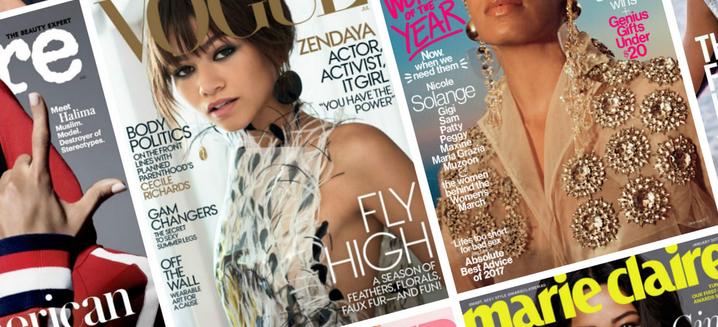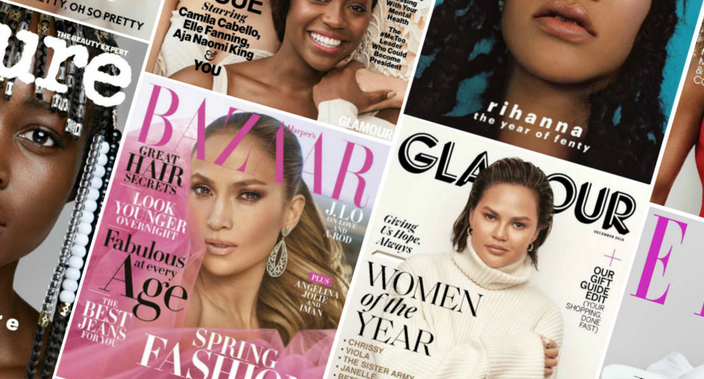In the ever-evolving landscape of the fashion industry, the concept of inclusivity has emerged as a driving force of change. Fashion magazines, once known for perpetuating narrow beauty ideals, have now taken a proactive stance in promoting diversity and representation. The journey toward inclusivity within these publications has been transformative, reshaping the way fashion is perceived and celebrated.

The Shift in Perspective: From Exclusivity to Inclusivity
Fashion magazines have historically been criticized for perpetuating unrealistic beauty standards that exclude individuals who don’t conform to these ideals. However, the industry has undergone a profound shift, acknowledging that beauty comes in all forms. This shift is evident in the way magazines feature models of different ethnicities, body types, genders, and ages.
Celebrating Diversity in Covers and Editorials
Inclusivity has taken centre stage on fashion magazine covers, where once homogeneous lineups have made way for a diverse array of faces. From actors and models to activists and athletes, covers now celebrate individuals who bring unique stories and perspectives to the forefront. These covers not only reflect the changing faces of fashion but also amplify voices that have long been marginalized.
Body Positivity and Breaking Stereotypes
The body positivity movement, fueled by a desire to challenge unrealistic body standards, has found a platform in fashion magazines. Editorials and features spotlight individuals who embrace their bodies and reject societal pressures. This shift helps break stereotypes and empowers readers to appreciate their bodies, regardless of shape or size.
Gender Fluidity and Non-Binary Representation
Fashion magazines are also leading the way in showcasing gender fluidity and non-binary representation. By featuring models who don’t conform to traditional gender norms, these publications are playing a vital role in promoting acceptance and understanding. This departure from rigid gender roles aligns with a growing cultural shift towards inclusivity.
Race and Ethnicity: Championing Diversity
In a globalized world, fashion magazines are acknowledging the importance of diverse representation. By featuring models and personalities from various racial and ethnic backgrounds, these publications reflect the rich tapestry of humanity. This recognition not only reflects the diverse readership but also counters stereotypes and prejudices that persist in mainstream media.
Beyond the Runway: Diversity Behind the Scenes
Inclusivity in fashion magazines goes beyond the images on the pages. Publishers are prioritizing diverse representation behind the scenes, from photographers and stylists to editors and creative directors. This commitment to inclusivity ensures that different perspectives shape the narratives presented, leading to more authentic and relatable content.
Challenges and Critiques: Navigating the Path to Inclusivity
While fashion magazines have made significant strides, challenges remain. Critics argue that some publications still tokenize diversity or resort to performative inclusivity. The road to true representation requires ongoing commitment, education, and an understanding of the nuanced complexities of inclusivity.
Empowerment through Representation
The impact of inclusive fashion magazines goes beyond aesthetics. Seeing individuals who look like them featured prominently empowers readers, fostering a sense of belonging and self-acceptance. It sends a powerful message that beauty and style are not limited to a single mould but encompass a spectrum of identities.
Inclusive Advertising and Brand Collaborations
Fashion magazines also influence advertisers and brands to adopt more inclusive strategies. Collaborations between magazines and brands often emphasize diversity, prompting the industry to rethink its marketing approach. These partnerships have the potential to influence the broader fashion landscape.
Fostering Conversations and Driving Change
Inclusive fashion magazines have become catalysts for crucial conversations about representation, equality, and social justice. By tackling topics that were once considered taboo or controversial, these publications are driving important dialogues that challenge societal norms.
The Road Ahead: Sustaining Inclusivity
While progress has been made, sustaining inclusivity remains paramount. Fashion magazines must continue to diversify their content, involve marginalized voices in decision-making, and listen to constructive feedback. Through ongoing education and openness, they can navigate the challenges and setbacks that come with fostering an inclusive environment.
Conclusion
In conclusion, the transformation of fashion magazines from exclusive platforms to champions of inclusivity signifies a pivotal moment in the industry’s history. Through the embrace of diverse voices, experiences, and identities, these publications are reshaping beauty standards, fostering empowerment, and driving meaningful change. As readers demand more representative content, fashion magazines have a crucial role to play in shaping a more inclusive future for fashion.

